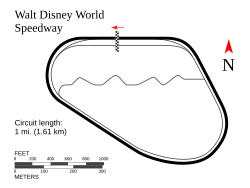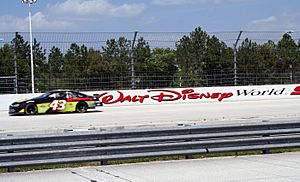Walt Disney World Speedway facts for kids
| The Mickyard | |
|---|---|

Tri-oval (1995–2015)
|
|
| Location | Floridian Way Walt Disney World Resort Bay Lake, Florida, U.S. |
| Time zone | UTC−05:00 (UTC−04:00 DST) |
| Coordinates | 28°23′48.02″N 81°34′39.61″W / 28.3966722°N 81.5776694°W |
| Capacity | 30,000 (2000–2015) 43,000 (1999) 51,000 (1996) |
| Owner | Walt Disney Company |
| Operator | IMS Events, Inc. |
| Broke ground | June 6, 1995 |
| Opened | November 28, 1995 |
| Closed | August 9, 2015 |
| Construction cost | $6 million |
| Architect | Kevin Forbes |
| Major events | Indy Racing League Indy 200 (1996–2000) NASCAR Craftsman Truck Series Chevy Trucks Challenge (1997–1998) U.S. F2000 National Championship (1996–1998) United States Auto Club#USAC Silver Crown Series (1998–2000) |
| Tri-oval (1995–2015) | |
| Surface | Asphalt |
| Length | 1.609 km (1.000 mi) |
| Turns | 3 |
| Banking | Turn 1: 10 degrees Turn 2: 8.5 degrees Turn 3: 7 degrees |
| Race lap record | 0:20.954 ( |
The Walt Disney World Speedway was a special place for car racing. It was located right inside the amazing Walt Disney World Resort in Bay Lake, Florida, close to Orlando.
This speedway was built in 1995 by a company connected to the famous Indianapolis Motor Speedway. It was mainly designed for a big race called the Indy 200 at Walt Disney World, which was part of the Indy Racing League.
Most of the time, the track was used for fun programs like the Richard Petty Driving Experience. These programs let fans either drive real race cars or ride along with a professional driver. After the year 2000, major racing series stopped using the track for competitions. However, many racing teams still used it for testing their cars. They liked the warm weather in Florida during the winter when other tracks were too cold. The speedway officially closed its doors forever on August 9, 2015.
Some magazines and newspapers even gave the track a cool nickname: "The Mickyard." This name combined Mickey Mouse, a famous Disney character, with "Brickyard," which is the nickname for the Indianapolis Motor Speedway.
Contents
History of the Disney Speedway
The track had a unique shape called a three-turn tri-oval. It was designed by Kevin Forbes, an engineer from the Indianapolis Motor Speedway. The perfect spot for the track was chosen in September 1994. It was a triangle-shaped piece of land right next to the Magic Kingdom's parking lot, near Disney's Polynesian Resort.
Plans for building the track were first announced in January 1995. The design was clever because it fit into the existing roads and buildings, so not much had to be changed.
On June 27, 1995, a special ceremony took place to start the construction. The chairman of the Indianapolis Motor Speedway even brought one of the original bricks from their famous "Brickyard" track to Disney. The one-mile (1.6 km) track was built very quickly. It used 10 miles (16 km) of safety cables, 2 acres (8,100 m²) of fencing, and over 5,200 tons of asphalt for the track surface. Even though there was a lot of rain, including a hurricane, the construction finished on time in October 1995.
The track was officially opened on November 28, 1995. Famous Indy Racing League drivers drove five cars in a special "Flying V" formation with fireworks. The first official car race, a Formula Ford 2000 event, happened on January 26, 1996. The very next day, the Indy Racing League held its Indy 200 car race there. Later, in February 1997, the Richard Petty Driving Experience, a program for fans, started at the Speedway.
Why the Speedway Closed
On March 27, 2015, Disney announced that the speedway would close on August 9, 2015. The track was taken down to make space for "transportation improvements." This meant expanding and changing the Magic Kingdom parking lot and its entrance. Eventually, a large lake was created on the site, along with the bigger parking area.
How the Speedway Was Designed
The Walt Disney World Speedway was built with a careful eye on the budget. This meant that many parts of the facility were not built to be permanent. The plan was to only build the track surface, the walls, and the safety fences. Other things like seating areas, restrooms, and race support buildings would be set up temporarily when needed. This was a new idea for an oval track, but it had worked well for temporary street races.
This plan saved a lot of money at first. Temporary seats and restrooms were put up each year for the January races. Not having permanent grandstands also allowed officials to change the seating size based on how many tickets were sold. However, this became difficult and expensive over time. The temporary seating took up part of the Magic Kingdom parking lot for almost three months, including during busy holidays like Christmas and New Year's.
Inside the track, there were three connected ponds shaped like Mickey Mouse. This pond, called "Lake Mickey," was added a year after the track opened to help with water drainage.
Parking Challenges at the Speedway
At first, having the track next to the Magic Kingdom parking lot seemed like a good idea. But after a few years, managing traffic on race days became a big problem. Race fans and regular Magic Kingdom visitors arrived at the same time, causing huge traffic jams.
In 1996–1997, Disney tried parking all race fans in the Magic Kingdom lot. They sent all Magic Kingdom guests to the Epcot parking lot instead. Race fans could walk to the Speedway, but Magic Kingdom guests had to take a monorail or bus from Epcot. This long trip made many guests unhappy. One year, a race ended early due to rain, and fans rushing to their cars caused severe traffic gridlock that lasted for hours.
Starting in 1998, race fans were sent to park at Epcot and then took a shuttle bus to the Speedway. Magic Kingdom guests parked in their usual lot. This helped theme park guests, but it made things less convenient for race fans. It also cost more money because Disney had to hire extra buses for the shuttle service.
End of Major Racing Events
In its early years, the track was often used for testing race cars all year round because of Orlando's warm winters. However, the track had some serious accidents. In January 1997, two Indy Racing League drivers, Eliseo Salazar and Davy Jones, were injured in crashes. Later, in January 2000, another Indy Racing League driver, Sam Schmidt, was seriously injured after a crash during testing. The track was built before a special safety barrier called the SAFER barrier was invented. Many people believe these barriers could have made the injuries less severe.
After the 2000 racing season, the Indy Racing League and Walt Disney World could not agree on a date for the 2001 race. The racing officials thought the January date was too early for teams to be ready. Disney was also worried about a conflict with the Super Bowl XXXV, which was happening around the same time in Tampa. Talks to move the race to a different time or even a new track did not work out. The race was then permanently removed from the Indy Racing League schedule.
Driving Experiences at the Speedway
In 1997, the track started hosting the Richard Petty Driving Experience. This program allowed people to drive real NASCAR stock cars or ride along with a professional driver. It became the main use for the track, operating almost every day of the year. To help with more cars coming and going, a one-lane car tunnel was built in 1997. In 1999, a new visitor's center and gift shop were built for the Richard Petty Driving Experience, along with a small garage.
In 2008, the track also welcomed the Indy Racing Experience. This program was similar, but it used IndyCar machines. Fans could ride in two-seater Indy cars or even drive them themselves. The Indy Racing Experience made the Walt Disney World Speedway its permanent home.
In 2012, a new program called the Exotic Driving Experience began. This allowed people to drive high-end "supercars." Special changes were made to the track's infield to create an "Exotics Course." This one-mile course combined parts of the oval track with a street-style course.
Other Uses of the Speedway
- In February 1999, the track hosted the 7th Annual SunDay Challenge. This event featured vehicles powered by alternative energy.
- In April 2002, the track was used for the first test of the new Infiniti Pro Series cars.
- The oval track was also part of the course for the Walt Disney World Marathon in some years.
Track Records
Indy Racing League Records
| Type | Distance | Date | Driver | Time | Average speed (mph) |
|---|---|---|---|---|---|
| Qualifying | 1 lap (1.0 miles) | January 25, 1996 | Buddy Lazier | 19.847 seconds | 181.388 |
| Race | 200 miles (320 km) | January 27, 1996 | Buzz Calkins | 1:33:30.748 | 128.748 |
- The fastest unofficial lap ever recorded at the track was by Buddy Lazier, who completed a lap in 19.450 seconds, reaching an average speed of 185.089 mph on January 13, 1996.
Fastest Lap Records
Here are the fastest official race lap records at Walt Disney World Speedway:
| Category | Time | Driver | Vehicle | Date |
|---|---|---|---|---|
| Tri-Oval: 1.609 km (1995–2015) | ||||
| Indy Racing League | 0:20.954 | Buzz Calkins | Reynard 95I | 1996 Indy 200 at Walt Disney World |
| U.S. F2000 | 0:28.212 | David Besnard | Van Diemen RF98 | 1998 Indy 200 |
Important Safety Information
From 1995 to 2015, the track had one very sad event. On April 12, 2015, a driving instructor named Gary Terry was seriously injured during a run as part of the Exotic Driving Experience. He was in the passenger seat of a Lamborghini Gallardo when the driver lost control and crashed. The Florida Highway Patrol investigated the incident. They determined it was an accident and no charges were filed against the driver.
See also
 In Spanish: Walt Disney World Speedway para niños
In Spanish: Walt Disney World Speedway para niños



